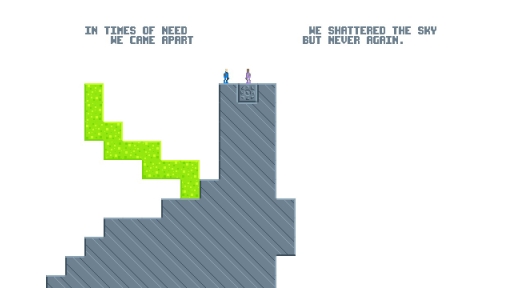Letting the Player Find the Fun

Ever notice how nobody ever wants to add more guesswork? The phrase is always “taking the guesswork out” of something, and lately, games are no exception. More and more games these days come loaded with overdone tutorials, excessive pop-ups and scripted “Press X to Do 1 of 1 Available Actions” sequences.
If you play a lot of modern console games, it can be hard to remember that guessing can be the core of a fun game experience. After all Twenty Questions is nothing but guessing. Crossword puzzles are made up of interlocking guesses, nudging you towards more answers the more you guess. In short, the fun of discovery has been getting the short shrift from major game releases in recent years.
Then, of course, you have Starseed Pilgrim.
“Gain from loss / one does not measure / but broken hearts / yield Starseed treasure” –Starseed Pilgrim
This is a game so dedicated to the concept of player discovery that, after leaving you stranded for hours with no hint about what you’re supposed to be doing, it proceeds to never explain anything. A critical indie darling and IGF nominee, Starseed Pilgrim has been lauded for its slowly unraveling ‘aha!’ moments, wholly unhindered by expository pop-ups or explanatory anything. We simply cannot talk about the specifics of the game, said the reviews. Doing so would spoil the sense of discovery so vital to the experience.
I had to see this underrated gem for myself. Buying it online and starting a new game, I had no expectations and dove in… and fifteen minutes later had no idea what to do. I seemed to be playing the same level over and over again, with no instructions on what to do aside from vague statements occasionally in verse.

Core game mechanics consist of planting different colored seeds on a square ‘planet’ floating in space, with each colored seed sprouting into a different ‘plant’ that behaves in a different way. Anticipating how each plant would grow makes up most of the minute-to-minute gameplay.
Well… this is boring. What if I try – aha! I had finally stumbled onto one of the ‘aha’ moments, and it was a nice feeling. Unfortunately, all it meant was even more planting gameplay, which had quickly started to become repetitive.
I played for a little longer before exiting the game, thinking about the Starseed‘s absolute lack of explanation.
If there had been a context established up front, would it have gotten the raves it did? If there were concrete objectives to aim for, would an even larger audience be interested in playing past the mandatory beguilement at the start? Would the mechanics alone be enough to maintain interest – or was the sense of discovery the dominant part of the appeal?
Let Them Figure It Out
Maybe Starseed Pilgrim wasn’t for me, but its critical success derived from a heavy reliance on the player’s curiosity makes an important statement. Mainstream games used to rely far more on discoverability than they do now. Remember the thrill of stumbling across the level warps in Super Mario Bros.? Or discovering the different effects of abilities in Super Metroid and Castlevania: Symphony of the Night?

Today’s mainstream games are much stingier with moments of player discoverability. In Bioshock Infinite, whenever a new Vigor power is introduced, all action halts so the player can watch a short animation explaining how the new ability works – followed immediately by pop-up text explaining the same exact ability in different words. What if players were just given the power, then simply left to try it out on their own in battle?
Of course, this would run the risk of their missing the point, which stresses the importance of careful accessibility design. Starseed is strictly built around ignoring this idea – if the player misses something and never advances, tough. Unfortunately, this will likely lead to the player’s getting bored and leaving, explaining the game’s low profile outside of indie circles (and as anything but a curiosity in itself). This is a failure on the game’s part in incorporating discoverability for the purposes of a greater audience.
Doing Discoverability Well
So how can you combine the magical sense of exploration that Starseed Pilgim does well with an experience that doesn’t alienate players? Here are a few ideas:
Make your intentions clear. At the start of the game, or as soon as possible, establish the game’s overarching rules: that not everything will be explained outright. Because every game is so different, establishing your game’s internal rules as fast and clearly as possible informs players what’s expected of them, and they’ll tailor their behavior accordingly. An example of this is the CD case puzzle in Metal Gear Solid – by requiring players to go outside the game world to solve the puzzle, this prompts the kind of fourth wall-breaking player behavior that leads to the infamous controller port-switching solution to the Psycho Mantis boss battle.
Lead the player blindfolded. What this means is, put the player in the context of a situation she needs to be in, but don’t tell her why. An example of this is in Super Metroid, when you come to the room with the three aliens who wall jump up a vertical passage, with the intention of the player teaching themselves how to wall jump. If the aliens weren’t here and the game relied on pure discoverability, the odds are much lower of the player suddenly teaching herself how to perform a wall jump. Conversely, if this was handled in an obvious tutorial section, any sense of exploration would be erased. Showing the player that something is possible, then leaving them to figure out the rest, incorporates discoverability in a structured way that prevents the player from getting frustrated and fed up.
Build in ‘accidents.’ If the player glosses over an ability or interaction, it can be helpful to include ways for him to ‘accidentally’ perform the action in order to engage his curiosity and prompt further exploration. This can help create an atmosphere of exciting surprises that increases overall engagement and encourages player experimentation. As an example, if Gears of War decided to not explain that executing a perfectly-timed Active Reload makes the player’s last few bullets extra powerful, they could have illustrated this in a multitude of other ways: making the player or his gun glow when a powered-up bullet is in the chamber; making enemies explode when hit with a powered-up bullet; or triggering special VO or sound effects.
There is immense power in discovering things yourself. Not only is it more fun than just executing what somebody else tells you to do, it endorses active learning and is more fulfilling in almost all applications. If your game needs a way to increase player agency and engagement, finding opportunities to increase player-driven moments of discovery may be a strategy worth accommodating.
